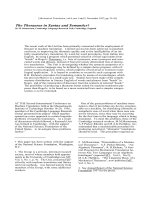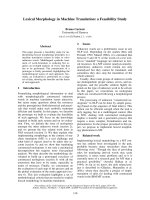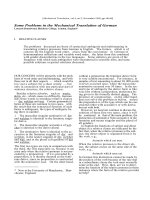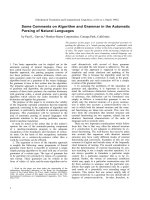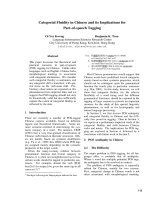Báo cáo khoa học: "SOME ISSUES IN PARSING AND NATURAL LINGUAGE UNDERSTANDING" pot
Bạn đang xem bản rút gọn của tài liệu. Xem và tải ngay bản đầy đủ của tài liệu tại đây (229.76 KB, 4 trang )
SOME
I33UE3
IH P&RSING AHD NATURAL LINGUAGE UNDERSTANDING
Robert J. Bobrow
Bolt Beranek and ~ewman Inc.
Bonnie L. Webber
Department of Computer & Information Science
University
of Pennsylvania
Lan&ua~e is a system for ancodln~ and
trans~tttlnK ideas. A theory that seeks to
explain llnKulstlc phenomena in terme of this
fact is a fun~t~1 theory. One that does not
• £sses the point. [10]
PREAMBLE
Our response to the questions posed to this panel is
influenced by a number of beliefs (or biasesl) which we
have developed in the course of building and analyzin~
the operation of several natural language understanding
(NLU) systems. [I, 2, 3, 12] While the emphasis of the
panel i~ on parslnK, we feel that the recovery of the
syntactic structure of a natural lan~unKe utterance
must be viewed as part of a larger process of
reeoverlnK the meaning, intentions and goals underlying
its generation. Hence it is inappropriate to consider
designing or evaluatln~ natural language parsers or
Erem,~ra without taking into account the architecture
of the whole ~LU system of which they're a part. I This
is the premise from which Our beliefs arise, beliefs
which concern two thinks:
o the distribution
of
various types of
knowledge, in particular syntactic knowledge,
amonK the modules of an NLU system
o the information and control Flow emonK those
modules.
As to the first belief, in the HLU systems we have
worked on, most syntactic information is localized in a
"syntactic module", although that module does not
produce a rallied data structure representing the
syntactlo description of an utterance. Thus, if
"parslnK" is taken as requlrln~ the production of such
a rallied structure, then we do not believe in its
necessity. However we do believe in the existence of a
module which provides syntactic information to those
other parts of the system whose decisions ride on it.
As
to
the second belief, we feel that syntax, semantics
and prattles effectively constitute parallel but
interacting processors, and that information such as
local syntactic relations is
determined by
Joint
decisions -monk them. Our experience shows that with
mlnir"al loss of efficiency, one can design these
processors to interface cleanly with one another, so as
to allow independent design, implementatlon and
modification. We spell out these beliefs in slightly
more detail below, and at greater length in [~].
1We are not claiming that the only factors shaping a
parser or a gr~-mar, beyond syntaotlo conslderatlofls,
are thlrLKs llke meanlng, intention, etc. There are
clearly mechanical and memory factors, aa well an
laziness - a speoXer's penchant for trylnK to get away
with the mdniEal level of effort needed to accomplish
the
taskf
97
The Comoutatiom~l Persneetive
The first set of question~ to this panel concern the
computational perspective, and the useful purposes
served by distinguishing parsing from interpretation.
We believe that syntactic knowledge plays an important
role in NLU. In particular, we believe that there is a
significant type of utterance description that can be
determined on purely syntactic grounds 2, albeit not
necessarily uniquely. This description can be used to
guide semantic and discourse level structure recovery
processes such as interpretation, anaphoric resolution,
focus tracking, given/new distinctions, ellipsis
resolution, etc. in a manner that is independent of the
lexical and conceptual content of the utterance. There
are several advantages to factoring out such knowledge
from the re,~-~nder of the NLU system and prowlding a
• syntactic module" whose interactions with the rest of
the system
provide
information on the syntactic
structure of an utterance. The first advantage is to
simplify system building, an we know fl-om
experience [I, 2, 3, 4, 5, 12]. Once the pattern of
communication between processors is settled, it is
easier to attach a new semnntlcs to the hooks already
provided in the Kr~,mar than to build a new semantic
processor. In addition, because each module ban only
to consider a portion of the constraints implicit in
the data (e.g. syntactic constraints, semantic
constraints and discourse context), each module can be
designed to optimize its own processing and provide an
efficient system.
The panel has also been charged wlth _ ~oslderlng
paa'allel processing as a challenge to its views on
parsing. Thls touches on our beliefs about the
Interaction among the modules that comprise the HLU
system. To respond to this issue, we first want to
dlstlngulsh between two types of parallelism: one, in
which many instances of the same thin6 are done at once ~
(an in an array of parallel adders-) and another, in
which the many thinks done slmul~aneously can be
different. Supporting this latter type of parallelism
doesn*t change our view of parsing, but rather
underlies it. We believe that the Interconnected
processes involved in NLU must support a banjo
o~eratinK pri~iple that Herman and Bobrow [14] have
called "The Principle of Continually Available Output":,
(CAO). This states that the Interactlng processes muat~
benin to provide output over a wide range of resource
allocations, even before their analyses are complete,
and even before all input data is available. We take
this position for two rensons: one, it facilitates
computational efficiency, and two, it seems to be
closer to human parsing ~rocesses (a point which we
will get to in answerlnK the next question).
The requirement that syntactic analysis, semantic
interpretation
and
discourse processlng must be able to
operate in (pseudo-)parallel, obeying the CAO
2that is, solely on the baa£s of syntactic
categories/features and ordering Information
principle, has sparked our interest in the design of
calrs of processes which can pass forward and backward
unet~Ll In/ormatlon/advlce/questlons as soon as
possible. The added potential for interaction of such
processors can increase the
capability and
efficiency
of the overall HLU process. Thus, for example, if the
syntactic module makes its intermediate decisions
available
to semantics
and~or
pragmatlcs, then those
processors can evaluate those decisions, guide syntax's
future behavior and, in addition, develop in parallel
their own analyses. Having sent on its latest
assertlon/advlce/question, whether syntax then decides
to
continue
on
with something else
or
walt
for
a
response will
depend on the
particular
kind of
message
sent. Thus, the parsers and grammars that concern us
are ones able to work with other appropriately designed
compoconts
to
support CAO. While the equipment we are
USing to implement and
test
our ideas is serial, we
take very seriously the notion of parallelism.
Finally under the heading of "Computational
Perspective", we are anked about what might motivate
our trying to make parsing procedures simulate what we
suspect human parsing processes to be like. One
motivation for us is the belief that natural language
is so tuned to the part extraordinary, part banal
cognitive capabilities of human beings that only by
simulating human parsing processes can we cover all and
only
the language
phenomena that
we
are
called
upon to
process. A particular (extraordinary) aspect of hu~an
cognitive (and hence, parsing) behavior that we want to
explore and eventually simulate is people's ability to
respond even under degraded data or resource
limitations. There are examples of listeners
initiating reasonable responses to an utterance even
before the utterance is complete, and in some case even
before a complete syntactic unit has been heard.
Simultaneous translation is ode notable example [8],
and another is provided by the performance of subjects
in a verbally guided assembly task reported by P. Cohen
[6]. Such an ability to produce output before all
input data
is available (or before enough processing
resources have been made available to produce the best
possible response) is what led Norman and Bobrow to
formulate their CAO Principle. Our interest is in
architectures for NLU systems which support CAO
and
in
• search
strategies through such architectures
for an
opti~"l interpretation.
The LimnLiStlC ~rs~etlve
We have been asked to comment on legitimate inferences
about human linsulstic competence and performance that
we can draw from our experiences with mechanical
parsing of
formal grammar. Our response is that
whatever parsing is for natural languages, it is still
only part of a larger process. Just because we know
what parsing is in formal language systems, we do not
secsssarily know what role it plays is in the context
Of total communication.
Simply
put, formal notions of
parsing underconstraln the goals
of
the syntactic
component of an NLU system. Efficiency meanures, based
on the resources required for generation of one or all
complete
parses for
s
sentence,
without
semantic
or
pra~e~-tlc Intera~tlon, do not secessarily specify
desirable properties of a natural language syntactic
analysis component.
As for whether the efficiency of parsing algorlthm~ for
CF or regular grammars suggest that the core of NL
igremmars la CF or regular, we want to dlstlngulsh that
part of perception (and hence, syntactic analysis)
which groups the stimulus into recognizable units from
that part which fills in gaps in in/ormatlon
(inferentially) on the baals of such groups. Results
in CF grammar theory says that grouping is not best
dose purely bottom-up,
that there are advantages
to
t ~
uslng predictive mechanlsms a~ well [9, 7]. Thls
snggests two things for parsing natural language:
I. There is a level of evidence and a process
for using it that is worEing to suggest
groups.
2. There is another filtering, inferenclng
mechanism that maEes predictions
and
diagnoses on the basis of those groups.
It is possible that the grouping mechanism may
make
use
of strategies applicable to CF parsing, such as well-
formed substrlng tables or charts, without requiring
the overall language specification be CF. In our
current RUS/PSI-ELONE system, grouping is a function of
the syntactic module: its output consists of suggested
groupings. These snggestlons may be at abstract,
specific or disjunctive. For example, an abstract
description m~ht be "this is the head of an NP,
everything to its left is a pre-modifler". Here there
is co comment about exactly how these pre-modlflers
group. A disjunctive description would consist of an
explicit enumeration of all the possibilities at some
point (e.g., "this is either a time prepositional
phrase (PP) or an agentive PP or a locative PP, etc.").
Disjunctive descriptions allow us
to prune.
possibilities via cane a~alysls.
In short, we believe in using as much evidence from
formal systemn a~ seems understandable
and
reasonable,
to
constrain
what
the
system should
be doing.
The Interaetlons
Finally, we have been asked about the nature of the
relationship between a gr~mar and a procedure for
applying it. On the systems building side, cur feeling
is that while one should be able to take a grammar and
convert it to a recognition or generation
procedure [I0], it is likely that such procedures will
embody a whole set of principles that are control
structure related, and not part of the grammar. For
example, a gr',-mr seed not specify in what order to
look for thln~s
or in
what order decisions should be
made. Thus, one may not be able to reconstruct the
grammar unlcuelv from a procedure for applying it.
On the other hand, on the b,m- parsing side, we
definitely feel that natural language is strongly tuned
to both people's means of production and their means of
recognition,
and
that principles llke MnDonalds '
Zndeliblllty
Pr"Inoiple
[13]
or
Marcus' Determinism
Hypothesis [11] shape what are (and are not) seen an
sentences of the language.
REFERENCES
I. Bobrow, R. J. The RUS System. BEN Report 3878,
Bolt Beranek and Rewman Inc., 1978.
2. Bobrow, R. J. & Webber, B. L. PSI-ELONE- Parsing
and Semantic Interpretation in the BBN Natural Language
Understanding System. CSCSI/C~EI0 Annual Conference,
CSC3I/CSEIO, 1980.
3. Bobrow, R. J. & Webber, B. L. Knowledge
Representation for Syntactic/Semantic Processing.
Proceedings of The First Annual National Conference on
Artiticial Intelligence, American Association for
Artificial Intelligence, 1980.
98
~. Bobrow, R.J. & Webber, B.L. Parsing and Semantic
Interpretation as an Incremental Recognition Process.
Proceedings of a Symposium on Modelling Human Parsing
Strategies, Center for Cognitive Science, University o[
Texas, Austin TZ, 1981.
5. Bobrow, R.J. & Webber, B.L. Systems Considerations
for Search by Cooperating Processes: Providing
Continually Ava/lable Output. Proceedings of the Sixth
IJCAI, International Joint Conference on Artificial
Intelligenoe, 1981.
6. Cohen, P. personal communication, videotape of
experimental task
7. Eau-ley, J. An efficient context-fl'ee parsing
algorithm. ~ of the ACM /~ (February
1970), 9~',- 102.
8. Gold~an-Eisler, F. Psyohologloal Heohanisms of
Speech Produotlon as SSudled through the Analysis of
Simultaneous Translation. In B. Butterworth, Ed.,
Lan~rn~e Production, Aoademlc Press, 1980.
9. Graham, S., Harrison, M. and Ruzzo, W. An Improved
Context-Free Recognizer. ACM ~ on
Pnom,-mm4,~ Lana~es and Systems (July 1980), "16-
@63.
10. Kay, M. An Algorithm for Compiling Parsing Tables
f~om a Grammar. Prooeedings of a Symposium on
Modelling Human Parsing Strate~Les, Center for
Cognitive Science, University of Texas, Austin TX,
1981.
11. MaPcus, M. A Theory of .qvntactic ~ for
Mat~al Lan~e. MIT Press, 1980.
12. Mark, W. S. & Barton, G. E. The RUSGrammar
Parsing System. GMR 32"3, General Motors Research
Laboratories, 1980.
13. MoDonald, D. ???. Ph.D. Th., Massachusetts
Institute o£ Technology, 1980.
I,. ~orman, D. & Bobrow, D. On Data-ii~ted and
Resource-llmlted ProoesSes. CSL7,-2, Xerox PARC, Msy,
197,.
99




